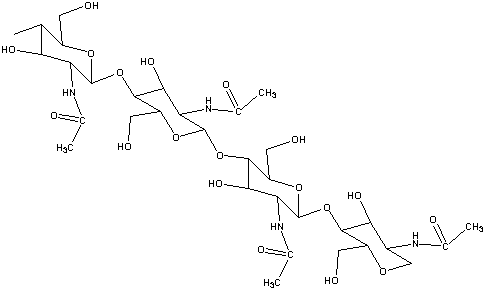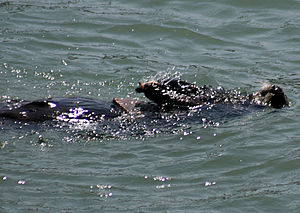Polymers from shelled creatures

Most of the creatures that have a shell of some
sort are usually found in or near a body of water. This includes clams,
oysters, crabs, and lobsters, and shrimp just to name a few of the main
players. There are many others, such as squids,
which aren't as well known for their shells, and
insects, most of which are not found in the sea. So we will stick with
the ones we know the most about and come from the ocean.
An abundance of natural polymers
are found in  these creatures that wear shells. Oddly enough it is
these shells which contain the most used polymers. Chitin is a polysaccharide
that is found in a
variety of creatures, from insects to fungi, but most abundantly in the
shells of crustaceans such as crabs, lobsters, and shrimp.
these creatures that wear shells. Oddly enough it is
these shells which contain the most used polymers. Chitin is a polysaccharide
that is found in a
variety of creatures, from insects to fungi, but most abundantly in the
shells of crustaceans such as crabs, lobsters, and shrimp.
Chitin looks like this:

Just so you know, chitin is not the only substance found in these shells, but like I said, it is the most used, as well as the most abundant. Protein is probably the second most used natural polymer that is found in shells and the creatures themselves, not to mention your own bones and hair.
Slow shelled creatures

Why call them that? Well, in a race between a lobster and a clam, I'd put my money on the lobster to win. Clams, oysters and mussels just don't move around much but they do make up another important family of the shelled creatures. Their pretty shells are one reason kids love to collect them when walking along the beach.
 These organisms feed on plankton and other microorganisms.
In turn, they feed larger creatures such as turtles,
starfish, squid, and shell-cracking fish of various
types. In addition, smart aquatic mammals such as the sea otter have learned
how to use rocks to break open oysters to get at the meat inside. And you thought
humans were the only creatures on earth to use tools?
These organisms feed on plankton and other microorganisms.
In turn, they feed larger creatures such as turtles,
starfish, squid, and shell-cracking fish of various
types. In addition, smart aquatic mammals such as the sea otter have learned
how to use rocks to break open oysters to get at the meat inside. And you thought
humans were the only creatures on earth to use tools?Some slow shelled creatures have only one shell (like abalone) while others have two shells that are hinged together. All of these shells contain chitin, but the most of the shell is a combination of calcium carbonate and a tanned protein. By this time in your exploration of the Polyquarium, I don't need to remind you what a protein looks like, right?
These creatures have the ability to secrete this protective polymer layer, which means they are able to produce it themselves and put it where it's needed. The shells these animals secrete is used in conjunction with materials they take from their environments and they then use that to make a natural composite material. A composite is simply a combination of two or more materials that work better together than the individual components. Got it?
Of course, they aren't the only creatures which secrete protective layers. Many animals which live on and around coral reefs also have layers they secrete.
Nature has its own recycling system. What is the most humbling about it is that we are not able to reproduce what nature has been practicing for millennia. But that is part of what science is all about, trying to find ways to replicate natural processes and materials so we enjoy the benefits without ill effects on nature's creatures and the environment.
Return to the Polyquarium